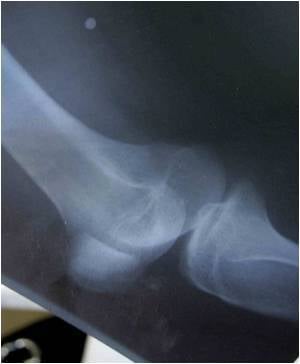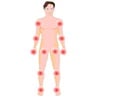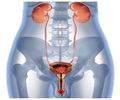Study says chronic lower back pain may be linked to a recently defined form of inflammatory arthritis known as axial spondyloarthritis

Chronic lower back pain is one of the most common pain syndromes with an unknown cause. Studies looking at chronic lower back pain have reported that a small percentage of these patients may have ankylosing spondylitis (a diagnosis that requires the development of changes on an X-ray and is therefore typically diagnosed as many as 10 years after symptoms arise). Because treatment of spondyloarthritis (including ankylosing spondylitis) may be most successful when the condition is diagnosed early, disease criteria for axial spondyloarthritis that allow for a diagnosis in the absence of radiographic changes have recently been published by the Assessment of Spondyloarthritis International Society, allowing for earlier diagnosis and institution of therapy.
Researchers recently set out to determine the prevalence of this rheumatic disease in people being seen by their primary care physicians for chronic lower back pain. Additionally, researchers aimed to assess the value of the clinical tests primary care physicians use to evaluate chronic lower back pain as well as the questionnaires about inflammatory back pain completed by patients when seeking help for this painful condition.
The researchers studied 364 primary care patients of whom 43 percent were male, with an average age of just over 36 years, and who had been experiencing chronic lower back pain symptoms for an average of nine years. Participants were identified through their primary care physician medical records, were asked to complete a questionnaire detailing inflammatory back pain, received a full physical examination by a rheumatologist, and their blood was tested to assess HLAB27-a gene associated with spondyloarthritis-and C-reactive protein - a blood test of inflammation.
X-rays and MRIs were taken of each participant''s sacroiliac joints (two joints that help make up the pelvis) and scored by two radiologists for the presence of inflammation and/or structural bone lesions typical axial spondyloarthritis.
The researchers diagnosed 77 participants (21.5 percent) with axial spondyloarthritis using the ASAS criteria; 52 were diagnosed with an MRI, 28 with X-ray and the presence of one other spondyloarthritis symptom, and 12 were diagnosed with a positive HLAB27 and two other spondyloarthritis symptoms. In all, 6.6 percent of the participants were diagnosed with the more stringent diagnosis of ankylosing spondylitis, which requires the presence of more advanced X-ray changes.
Advertisement
"The study confirms that there is a direct link between chronic lower back pain and spondyloarthritis," says Angelique Weel, PhD, MD; a rheumatologist at the Maasstadziekenhuis Rotterdam and an investigator in the study. "Such patients diagnosed by primary care physicians could be helped early in their disease by referral to a rheumatologist."
Editor''s Notes: Lonneke van Hoeven will present this research during the ACR Annual Scientific Meeting at the Georgia World Congress Center at 4:30 PM on Wednesday, November 10 in Room A 311. Dr. Weel will be available for media questions and briefing at 1:30 PM on Tuesday, November 9 in the on-site press conference room, B 212.
Learn more about living well with rheumatic disease as well as rheumatologists and the role they play in health care.
Presentation Number: 2180
Striking prevalence of Axial Spondyloarthritis in primary care patients with chronic low back pain; a cross-sectional study
Lonneke van Hoeven (Maasstadziekenhuis, The Netherlands)
Jolanda Luime, PhD (Erasmus Medical Center, The Netherlands)
Huub Han, MD (Maasstadziekenhuis, The Netherlands)
Angelique Weel, MD, PhD (Maasstadziekenhuis, The Netherlands)
Body: Background: Chronic low back pain (CLBP) is one of the most common pain syndromes with unknown cause. Few studies however report that 5-7 % is caused by Ankylosing Spondylitis (AS), a disease that until recently could be diagnosed 7-10 years after first presentation of symptoms. Since treatment of AS is most successfully in an early stage of the disease, the ASAS group1 developed new criteria to diagnose axial Spondyloarthritis (aSpA) early. Early treatment requires early recognition and should therfore be done in primary care. Until now however, prevalences of aSpA in primary care patients with CLBP are missing.
Purpose: To determine the prevalence of aSpA in primary care patients with CLPB classified by ASAS criteria. To assess the diagnostic value of clinical tests commonly available to GPs and inflammatory back pain (IBP) questionnaires completed by patients themselves.
Method: In this cross-sectional study primary care patients with CLBP aged 19-45 years were identified from GP records by the International Classification of Primary Care code L03. All patients completed IBP questionnaires, (ASAS, Calin and Berlin) and underwent a complete history and physical examination by rheumatologist. Blood was drawn to assess HLAB27 and CRP. Sacroiliac joints (SIJ) were imaged by conventional radiography and MRI (Siemens Essenza). All images were scored by two experienced MSD radiologist, without any clinical information. Radiographic sacroiliitis was defined by Modified New York criteria and MRI (T1, T2 and fat suppression series) evaluation followed ASAS recommendations.1 Definite aSpA was defined by the ASAS criteria of aSpA.1 Statistics were performed by using chi-square and logistic regression analysis.
Results: 364 patients (43% male, 36.3 yrs(sd 6.8), 9 yrs (sd 7.44) of symptoms) were evaluated. The overall point prevalence of aSpA was 21.5 % (n= 77; ) using the ASAS criteria, n=52 were diagnosed by the MRI criteria with one other SpA feature and n=12 were diagnosed by a positive HLA B 27 and two other SpA features. Based on the modified New York criteria we identified 6.6% (n = 24) of which 75% also fulfilled the ASAS criteria. Figure 1 shows the diagnostic value of characteristics available to GPs and IBP questionnaires. Highest post probability test were achieved for the diagnostic test HLA-B27 and X-SIJ with respectively 68.3% and 75%.
Conclusion: In this cross-sectional study of primary care patients with CLBP the prevalence of aSpA based on the ASAS criteria is strikingly high. Additional ''red flag'' symptoms determined by medical history and IBP questionnaires have modest diagnostic value. However, determine HLA-B27 and X-ray of SIJ could help physicians in primary care identifying patients that should have accelerated referral to rheumatologist to start accurate treatment as early as possible.
Source-Newswise









